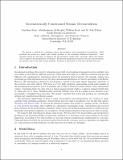| dc.contributor.author | Kane, Jonathan | |
| dc.contributor.author | Al-Moqbel, Abdulrahman | |
| dc.contributor.author | Rodi, William | |
| dc.contributor.author | Toksoz, M. Nafi | |
| dc.contributor.other | Massachusetts Institute of Technology. Earth Resources Laboratory | en_US |
| dc.date.accessioned | 2011-12-21T20:43:16Z | |
| dc.date.available | 2011-12-21T20:43:16Z | |
| dc.date.issued | 2002 | |
| dc.identifier.uri | http://hdl.handle.net/1721.1/67851 | |
| dc.description.abstract | We present a method for combining seismic deconvolution and geostatistical interpolation. Both
problems are posed as a single joint inverse problem in the maximum likelihood framework. Joint
inversion allows for well data to improve the deconvolution results and, conversely, allows the seismic
data to improve the interpolation of well data. Traditional interpolation and trace-by-trace deconvolution
are special cases of the joint inverse problem. Inversion is performed on 2-D and 3-D field data sets. | en_US |
| dc.description.sponsorship | Massachusetts Institute of Technology. Earth Resources Laboratory | en_US |
| dc.publisher | Massachusetts Institute of Technology. Earth Resources Laboratory | en_US |
| dc.relation.ispartofseries | Earth Resources Laboratory Industry Consortia Annual Report;2002-08 | |
| dc.subject | Inversion | |
| dc.title | Geostatistically Constrained Seismic Deconvolution | en_US |
| dc.type | Technical Report | en_US |
| dc.contributor.mitauthor | Kane, Jonathan | |
| dc.contributor.mitauthor | Al-Moqbel, Abdulrahman | |
| dc.contributor.mitauthor | Rodi, William | |
| dc.contributor.mitauthor | Toksoz, M. Nafi | |
| dspace.orderedauthors | Kane, Jonathan; Al-Moqbel, Abdulrahman; Rodi, William; Toksoz, M. Nafi | en_US |

